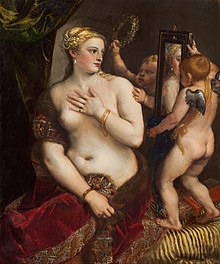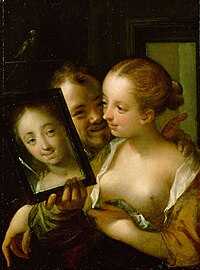
A mirror, also known as a looking glass, is an object that reflects an image. Light that bounces off a mirror will show an image of whatever is in front of it, when focused through the lens of the eye or a camera. Mirrors reverse the direction of the image in an equal yet opposite angle from which the light shines upon it. This allows the viewer to see themselves or objects behind them, or even objects that are at an angle from them but out of their field of view, such as around a corner. Natural mirrors have existed since prehistoric times, such as the surface of water, but people have been manufacturing mirrors out of a variety of materials for thousands of years, like stone, metals, and glass. In modern mirrors, metals like silver or aluminium are often used due to their high reflectivity, applied as a thin coating on glass because of its naturally smooth and very hard surface.

Symmetry in everyday life refers to a sense of harmonious and beautiful proportion and balance. In mathematics, the term has a more precise definition and is usually used to refer to an object that is invariant under some transformations, such as translation, reflection, rotation, or scaling. Although these two meanings of the word can sometimes be told apart, they are intricately related, and hence are discussed together in this article.

Stereoscopy is a technique for creating or enhancing the illusion of depth in an image by means of stereopsis for binocular vision. The word stereoscopy derives from Greek στερεός (stereos) 'firm, solid' and σκοπέω (skopeō) 'to look, to see'. Any stereoscopic image is called a stereogram. Originally, stereogram referred to a pair of stereo images which could be viewed using a stereoscope.

Las Meninas is a 1656 painting in the Museo del Prado in Madrid, by Diego Velázquez, the leading artist of the Spanish Baroque. It has become one of the most widely analyzed works in Western painting for the way its complex and enigmatic composition raises questions about reality and illusion, and for the uncertain relationship it creates between the viewer and the figures depicted.

Olympia is a 1863 oil painting by Édouard Manet, depicting a nude white woman ("Olympia") lying on a bed being attended to by a black maid. The French government acquired the painting in 1890 after a public subscription organized by Claude Monet. The painting is now in the Musée d'Orsay, Paris.

The Rokeby Venus is a painting by Diego Velázquez, the leading artist of the Spanish Golden Age. Completed between 1647 and 1651, and probably painted during the artist's visit to Italy, the work depicts the goddess Venus in a sensual pose, lying on a bed with her back facing the viewer, and looking into a mirror held by the Roman god of physical love, her son Cupid. The painting is in the National Gallery, London.

The term composition means "putting together". It can be thought of as the organization of the elements of art according to the principles of art. Composition can apply to any work of art, from music through writing and into photography, that is arranged using conscious thought.
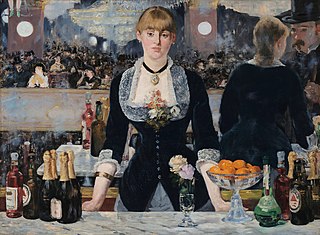
A Bar at the Folies-Bergère is a painting by Édouard Manet, considered to be his last major work. It was painted in 1882 and exhibited at the Paris Salon of that year. It depicts a scene in the Folies Bergère nightclub in Paris. The painting originally belonged to the composer Emmanuel Chabrier, a close friend of Manet, and hung over his piano. It is now in the Courtauld Gallery in London.
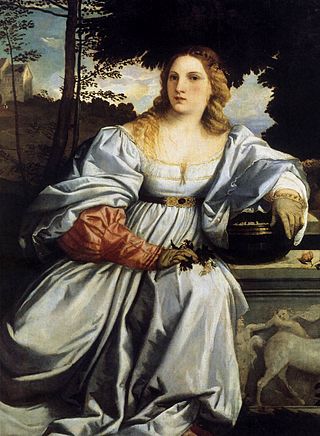
Sacred and Profane Love is an oil painting by Titian, probably painted in 1514, early in his career. The painting is presumed to have been commissioned by Niccolò Aurelio, a secretary to the Venetian Council of Ten, whose coat of arms appears on the sarcophagus or fountain, to celebrate his marriage to a young widow, Laura Bagarotto. It perhaps depicts a figure representing the bride dressed in white, sitting beside Cupid and accompanied by the goddess Venus.
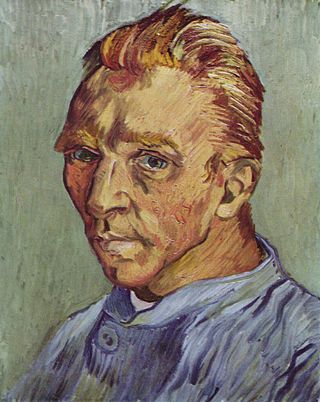
A self-portrait is a portrait of an artist made by themselves. Although self-portraits have been made since the earliest times, the practice of self-portraiture only gaining momentum in the Early Renaissance in the mid-15th century that artists can be frequently identified depicting themselves as either the main subject, or as important characters in their work. With better and cheaper mirrors, and the advent of the panel portrait, many painters, sculptors and printmakers tried some form of self-portraiture. Portrait of a Man in a Turban by Jan van Eyck of 1433 may well be the earliest known panel self-portrait. He painted a separate portrait of his wife, and he belonged to the social group that had begun to commission portraits, already more common among wealthy Netherlanders than south of the Alps. The genre is venerable, but not until the Renaissance, with increased wealth and interest in the individual as a subject, did it become truly popular.
The psychology of art is the scientific study of cognitive and emotional processes precipitated by the sensory perception of aesthetic artefacts, such as viewing a painting or touching a sculpture. It is an emerging multidisciplinary field of inquiry, closely related to the psychology of aesthetics, including neuroaesthetics.

In critical theory, philosophy, sociology, and psychoanalysis, the gaze, in the figurative sense, is an individual's awareness and perception of other individuals, other groups, or oneself. Since the 20th century, the concept and the social applications of the gaze have been defined and explained by phenomenologist, existentialist, and post-structuralist philosophers. Jean-Paul Sartre described the gaze in Being and Nothingness (1943). Michel Foucault, in Discipline and Punish: The Birth of the Prison (1975), developed the concept of the gaze to illustrate the dynamics of socio-political power relations and the social dynamics of society's mechanisms of discipline. Jacques Derrida, in The Animal That Therefore I Am (1997), elaborated upon the inter-species relations that exist among human beings and other animals, which are established by way of the gaze.

The Venetian painter Titian and his workshop made at least six versions of the same composition showing Danaë, painted between about 1544 and the 1560s. The scene is based on the mythological princess Danaë, as – very briefly – recounted by the Roman poet Ovid, and at greater length by Boccaccio. She was isolated in a bronze tower following a prophecy that her firstborn would eventually kill her father. Although aware of the consequences, Danaë was seduced and became pregnant by Zeus, who, inflamed by lust, descended from Mount Olympus to seduce her in the form of a shower of gold.

A Man with a Quilted Sleeve is a painting of about 1510 by the Venetian painter Titian in the National Gallery, London, measuring 81.2 by 66.3 centimetres. Though the quality of the painting has always been praised, there has been much discussion as to the identity of the sitter. It was long thought to be a portrait of Ariosto, then a self-portrait, but since 2017 has been called Portrait of Gerolamo (?) Barbarigo by the gallery, having also been called merely Portrait of a Man, the title used here, The Man with the Blue Sleeve, and no doubt other variants.

Venus and Musician refers to a series of paintings by the Venetian Renaissance painter Titian and his workshop.

Venus with a Mirror is a painting by Titian, now in the National Gallery of Art in Washington, DC, and it is considered to be one of the collection's highlights.
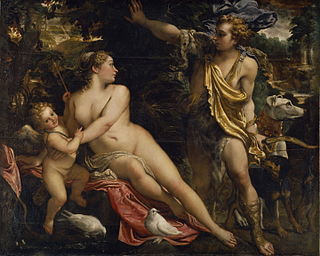
Venus, Adonis and Cupid is a painting created c. 1595 by Annibale Carracci. The painting is in the Museo del Prado, Madrid. Annibale Carracci was one of the most well known Italian Baroque painters of the seventeenth century. The Carracci brothers established an academy of art called Accademia degli Incamminati, which pioneered the development of Bolognese Painting. Annibale Carracci and Caravaggio were among the most influential artists of this century, who through their unique artistic styles led to the transition from Mannerist to Baroque. Annibale was born in Bologna in 1560 and died in Rome in 1609.

In feminist theory, the male gaze is the act of depicting women and the world in the visual arts and in literature from a masculine, heterosexual perspective that presents and represents women as sexual objects for the pleasure of the heterosexual male viewer. The concept was first articulated by British feminist film theorist Laura Mulvey in her 1975 essay, Visual Pleasure and Narrative Cinema. Mulvey's theory draws on historical precedents, such as the depiction of women in European oil paintings from the Renaissance period, where the female form was often idealized and presented from a voyeuristic male perspective. Art historian John Berger, in his work Ways of Seeing (1972), highlighted how traditional Western art positioned women as subjects of male viewers’ gazes, reinforcing a patriarchal visual narrative.

The Pardo Venus is a painting by the Venetian artist Titian, completed in 1551 and now in the Louvre Museum. It is also known as Jupiter and Antiope, since it seems to show the story of Jupiter and Antiope from Book VI of the Metamorphoses. It is Titian's largest mythological painting, and was the first major mythological painting produced by the artist for Philip II of Spain. It was long kept in the Royal Palace of El Pardo near Madrid, hence its usual name; whether Venus is actually represented is uncertain. It later belonged to the English and French royal collections.

Marco Bertamini is a professor of psychology in the Department of General Psychology, of the University of Padova, Italy.

